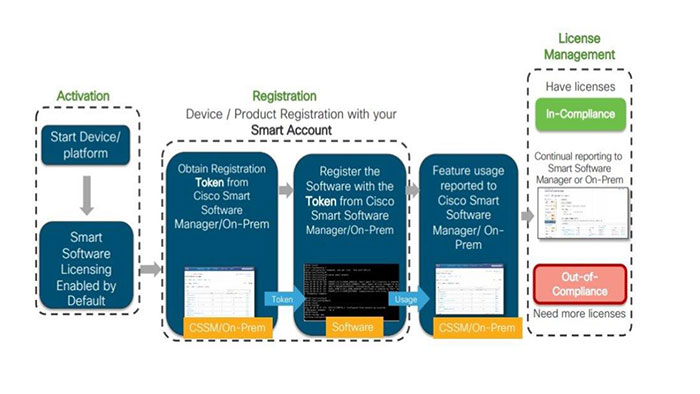
A Cisco Smart Account in simple terms is a container that allows you to organize all of your Cisco licenses, devices and license agreements. It also allows you to control access to these assets in the future. smart accounts will allow you to organize all of your Cisco subscriptions licenses, devices and services.
Anyone who has a Cisco ID can request a smart account and it’s free. The smart account is already mandatory for many popular Cisco products and you must have a smart account to order and receive smart license products.
Smart accounts provide organizations with greater visibility into their investments. It enables improved self-management providing a single location for customers and partners to organize all their assets in a centralized transparent secure way.
You can place orders and deposit them directly into a smart account second. After that, smart accounts provide real-time visibility into what I own and use. For example, this can help you know how your licenses are being consumed and by which device.
Furthermore, in the world of PAK (Product Activation Key), all licenses are assigned to individuals while in the world of smart accounts, all licenses and devices are stored in one central location for the entire organization which helps you control access to these assets providing increased control.
Finally, smart accounts allow you to adjust access based on the legal and functional needs of your company. it provides full visibility and insights for renewals and new purchases.
there are two types of smart accounts: A Customer Smart Account and a Partner Holding Account.

A customer smart account is where licenses are stored and organized for a customer to access, activate and manage them. A partner holding account is used by a partner or distributor to temporarily store an order until the customer smart account is known.
Partners who consume licenses for their own use will also need a customer smart account in addition to their partner holding account. It is important to remember that licenses can only be consumed in a customer smart account and not in a partner holding account.
Both the customer smart account and partner holding accounts can also have virtual accounts. Virtual accounts act as subfolders to organize licenses and users within the smart account.

It is important to understand the different roles you can be assigned in a smart account because your role determines what you can access and manage. Smart account approvers are responsible for approving the smart licensing terms of agreement. Smart account administrators create and manage the smart account any virtual accounts and enable user access.
Smart account users manage licenses within all virtual accounts but do not have the ability to manage users or to delete accounts. Within a virtual account you can be assigned one of two roles.
Virtual account administrators manage licenses and provide users access to their assigned virtual accounts. virtual account users can manage the licenses only within their assigned virtual account.
To wrap it up, some of the more common virtual account structures include by location, technology group, business department or reporting structure. Remember that if you do not assign licenses to a virtual account they will be assigned to the default virtual account.
Note: Avoid creating multiple customer smart accounts for your company as you cannot transfer licenses and devices between your smart accounts. licenses can only be consumed in a customer smart account.
Smart account is where you set up the profile and organize your licenses and devices but to view and manage them you will have to access the individual licensing platforms(LRP), Cisco Smart Software Manager (CSSM) and an Enterprise Agreement(EA) workspace.
LRP shows only your Cisco Classic License capabilities while CSSM captures both your smart license and hybrid license capabilities. the EA workspace provides you with access to your enterprise agreements.
